
Discover the ultimate combination for transforming your windows into stunning focal points that exude style and functionality. This comprehensive guide delves into the enchanting world of plantation shutters and curtains, exploring how these elements harmonize to create a truly captivating ambiance for any interior space. Whether seeking privacy, light control, or refined sophistication, plantation shutters with curtains offer a versatile solution that transcends trends and stands the test of time.
Understanding the Allure of Plantation Shutters
Plantation shutters are a type of window treatment characterized by their wide louvers or slats, which can be adjusted to control the amount of light and privacy in a room. They are typically installed on the interior side of windows and offer a timeless and elegant aesthetic.
Distinguishing features of plantation shutters include:
- Wide slats: Plantation shutters are known for their wider slats compared to other types of shutters, typically ranging from 2.5 to 4.5 inches. These larger slats provide a more unobstructed view when opened and create a visually appealing look when closed.
- Adjustable louvers: One of the critical features of plantation shutters is their ability to adjust the angle of the slats. This allows for precise control over the amount of natural light entering the room and enables privacy control by blocking or opening the view from outside.
- Solid construction: Plantation shutters are made from durable wood, vinyl, or composite materials. This solid construction ensures longevity and adds a substantial feel to the window treatment.
- Versatility: Plantation shutters can be customized to fit various window shapes and sizes, including standard windows, bay windows, and even specialty-shaped windows. This versatility makes them suitable for any room in your home.
Benefits of plantation shutters: Light control, privacy, and energy efficiency
- Light control: With plantation shutters, you have precise control over the amount of natural light entering your space. By adjusting the angle of the slats, you can direct the light to create a desired ambiance, reduce glare, and protect your furniture and flooring from fading due to direct sunlight.
- Privacy: Plantation shutters offer excellent privacy control. When the shutters are closed, the adjustable slats prevent outsiders from looking inside while allowing some light to filter through. You can adjust the slats to balance privacy and natural light.
- Energy efficiency: Plantation shutters provide additional insulation to your windows. When closed, they create an effective barrier against heat transfer, helping to keep your home cooler in summer and warmer in winter. This can lead to energy savings and improved comfort.
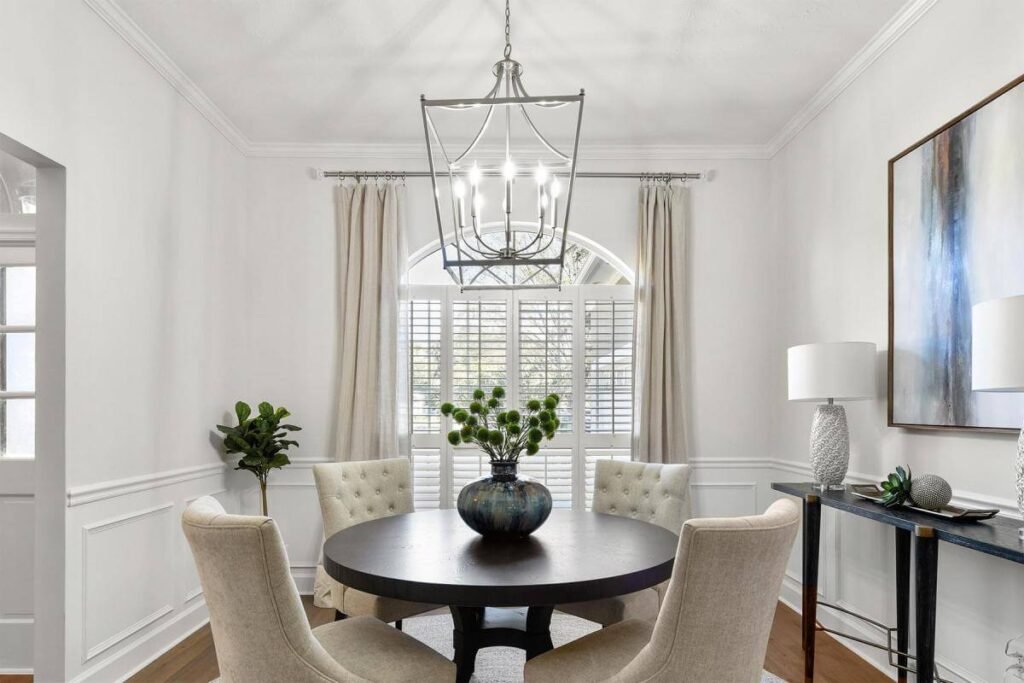
Materials and design options for plantation shutters
- Wood: Wood plantation shutters exude a classic and luxurious feel. They are available in various wood species, such as basswood, cedar, and oak, each offering unique grain patterns and finishes. Wood shutters can be stained or painted to match your interior decor.
- Vinyl: Vinyl plantation shutters are a durable and affordable option. They are moisture-resistant, making them suitable for high-humidity areas such as bathrooms and kitchens. Vinyl shutters are available in various colors and finishes.
- Composite: Composite plantation shutters combine the benefits of both wood and vinyl. They are made from wood fibers and synthetic materials, offering enhanced durability and warping, cracking, and fading resistance. In addition, composite shutters can be customized with different finishes to match your style.
Tips for selecting the perfect plantation shutters to complement your style and space
- Consider your interior style: Choose plantation shutters that complement the overall aesthetic of your space. For traditional decor, opt for rich wood shutters with elegant finishes. Consider clean-lined shutters in a neutral color or sleek vinyl shutters for a more contemporary or minimalist style.
- Assess your window size and shape: Plantation shutters can be customized to fit windows of various sizes and shapes. Consider the proportions and design of your windows to determine the appropriate louver size and configuration.
- Evaluate your light and privacy needs: Determine each room’s light control and privacy level. Consider shutters with smaller louvers or a hidden tilt rod for enhanced privacy for bedrooms or street-facing windows.
- Take maintenance into account: Different materials require different maintenance routines. Consider the ease of cleaning and upkeep when selecting plantation shutters. Vinyl and composite shutters generally require less maintenance than wood shutters, which may require occasional refinishing or re-staining.
- Consult with a professional: Seeking advice from a reputable window treatment specialist or an interior designer can help you navigate the options and make an informed decision that suits your needs and preferences.
Exploring the Versatility of Curtains
Curtains play a crucial role in interior design, offering versatility and the ability to transform the look and feel of a space. They go beyond mere window coverings, adding texture, color, and dimension to a room.
Here are some ways in which curtains can enhance your interior design.
- Softening and framing windows: Curtains soften the appearance of windows, creating an inviting and cozy atmosphere. They also state the view outside, drawing attention to the beauty of the outdoors.
- Adding visual interest and focal points: With their varied colors, patterns, and textures, curtains can become a focal point in a room. They contribute to the overall aesthetic and style, making a statement or blending seamlessly with the existing decor.
- Creating depth and dimension: Curtains add depth and dimension to a space, making it appear larger and more layered. They create visual interest by introducing different levels and textures.
- Controlling light and privacy: Along with plantation shutters, curtains provide additional control over light and privacy. They can be used to filter or block natural light, depending on the thickness and opacity of the fabric. Sheer curtains allow light to pass through, while heavier drapes provide more privacy and light control.
Types of curtains and their respective effects.
- Sheer curtains: Sheer curtains are lightweight and translucent, allowing diffused natural light to enter while still providing privacy. They add an airy and ethereal feel to a room and are ideal for spaces where privacy is not a significant concern, such as living rooms and dining areas.
- Blackout curtains are made from opaque fabrics that block out light, making them perfect for bedrooms or spaces where you want to create a cozy and dark environment. They are also effective at insulating against outside noise and temperature fluctuations.
- Thermal curtains: Thermal curtains are designed with insulating properties, helping to regulate the temperature in a room. They can help keep your space cool in the summer and warm in the winter, reducing energy consumption and providing soundproofing benefits.
- Patterned curtains: Patterned curtains add visual interest and personality to a room. They can range from bold and vibrant designs to subtle and understated patterns, depending on your style and the overall decor scheme.
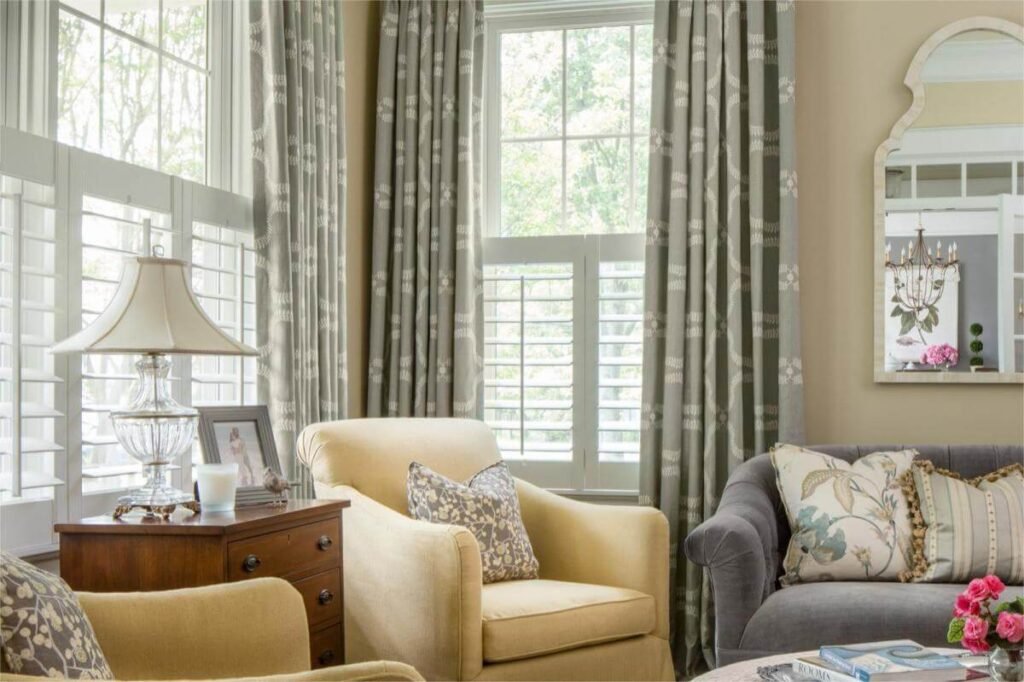
Curtain fabrics and patterns: Choosing the right textures and colors.
- Fabric textures: Consider the surface of the curtain fabric and how it complements the room’s overall aesthetic. Options include silk, linen, velvet, cotton, and synthetic materials. Each fabric has its unique texture and drape, so choose one that aligns with your desired look and feel.
- Color selection: The color of the curtains can significantly impact the ambiance of a room. Neutral colors such as white, beige, and gray create a calming and versatile backdrop, while bolder colors can add drama and make a statement. Consider the existing color palette and choose curtains that blend harmoniously or create contrast for visual impact.
- Pattern considerations: Patterns can add visual interest and personality to curtains. Choose patterns that complement the overall decor scheme and furniture in the room. A few options are floral, geometric, striped, or abstract patterns.
Practical considerations: Length, fullness, and hanging options.
- Length: Determine the desired size of the curtains based on the style and functionality you want to achieve. Floor-length curtains create a formal and elegant look, while curtains that end just below the window sill can create a more casual and relaxed atmosphere.
- Fullness: Consider the desired fullness or gathering of the curtains when closed. More fabric creates a luxurious and voluminous look, while less material makes a sleek and tailored appearance.
- Hanging options: Explore different hanging options, such as curtain rods, tracks, or rings, to find the best fit for your curtains and windows. Consider the overall aesthetic and functionality of the hanging system, ensuring that it complements the style of the curtains and is easy to operate.
By carefully selecting suitable types of curtains, fabrics, and patterns and considering practical aspects such as length and hanging options, you can enhance your interior design, create a cohesive look, and achieve the desired atmosphere in each room.
The Art of Pairing Plantation Shutters with Curtains
When pairing plantation shutters with curtains, achieving a harmonious balance between the two is vital. Consider the following tips to coordinate colors and materials effectively.
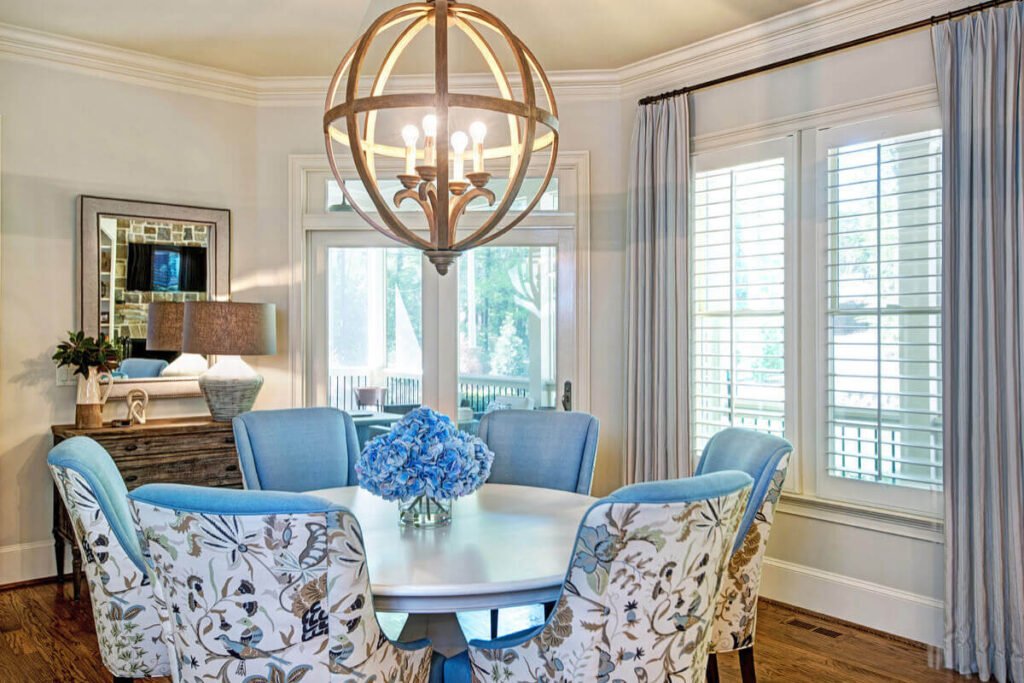
- Complementary colors: Choose curtain colors that complement the color of your plantation shutters. Opt for harmonized shades, creating a cohesive and visually pleasing combination. For example, if your shutters are white, consider curtains in soft pastel tones, neutrals, or even bold contrasting colors for a striking effect.
- Material coordination: Pay attention to the materials of both the shutters and curtains to ensure they work together seamlessly. For instance, if you have wooden plantation shutters, consider curtains in fabrics that have a similar texture or complement the wood’s natural tones. If your shutters are made of vinyl or composite, you have more flexibility with certain materials, such as silk, linen, or even heavier drapery fabrics.
- Patterns and prints: Coordinate patterns and prints between the shutters and curtains for a cohesive look. If your plantation shutters have a simple and clean design, you can introduce patterns or prints in the curtains to add visual interest. Conversely, if your shutters have decorative details or a textured finish, opt for solid-colored or subtle patterned curtains to avoid overwhelming the space.
Layering aesthetics: Utilizing curtains to soften the look of shutters.
One of the advantages of pairing plantation shutters with curtains is the ability to soften the overall look and add a touch of elegance. Consider the following techniques for effective layering:
- Sheer curtains: Layering sheer curtains over plantation shutters adds a soft and ethereal quality to the window treatment. Sheer fabrics allow natural light to filter through while creating a gentle and romantic ambiance. This combination works well in living rooms, bedrooms, and dining areas.
- Drapery panels: Hang full-length drapery panels on either side of the shutters to create a more formal and luxurious look. The panels can be made of heavier fabrics that offer more privacy and light control. This layering technique adds depth, texture, and a sense of luxury to the window.
- Valances or top treatments: Install valances or top treatments above the plantation shutters to enhance the decorative aspect of the window. Valances can be made of fabric, wood, or other materials and serve as a decorative accent while concealing the top portion of the shutters. They can be tailored or pleated, depending on the desired style.
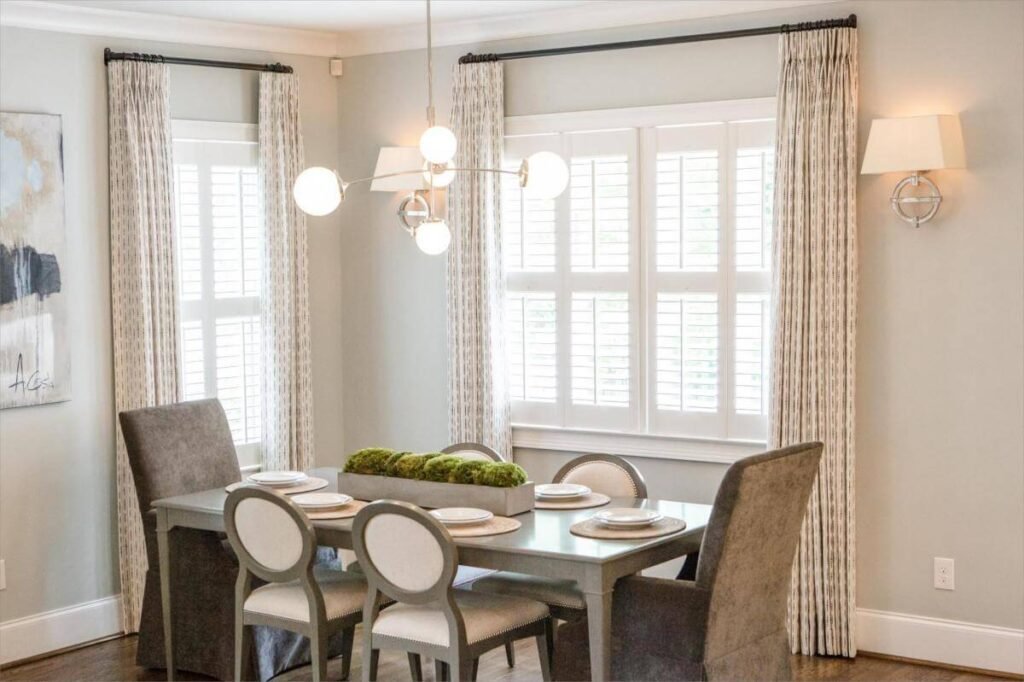
Enhancing functionality: Combining light control and privacy features.
Pairing plantation shutters with curtains not only enhances aesthetic appeal but also improves functionality, especially in terms of light control and privacy. Consider the following ways to maximize these features:
- Dual functionality: Plantation shutters offer excellent control over light and privacy. However, when combined with curtains, you can further fine-tune these aspects. During the day, open the shutters and let natural light flood the space while maintaining privacy with the partially drawn curtains. In the evening, close the shutters entirely for enhanced privacy and add a layer of curtains for light-blocking capabilities.
- Layered opacity: If privacy is a top priority, choose curtains with different opacity levels. Sheer curtains can be used for daytime privacy while allowing natural light to filter through. Pair them with blackout or heavier curtains for nighttime privacy and light control. This layered approach will enable you to adjust privacy and light levels according to your daily needs.
Curtain styles complement different types of plantation shutters.
- Classic elegance: Traditional plantation shutters with floor-length draperies exude timeless elegance. Opt for curtain styles such as pinch or goblet pleat to enhance the formal and refined aesthetic. Use luxurious fabrics like silk or velvet for a touch of luxury.
- Contemporary sophistication: Pair sleek and minimalistic plantation shutters with curtains in simple and clean designs. Consider grommet or rod pocket curtains with crisp lines for a modern, sophisticated look. Opt for fabrics like linen or cotton in neutral or monochromatic colors to maintain a sleek and minimalist vibe.
- Rustic charm: If your plantation shutters have a rustic or natural wood finish, complement them with curtains in earthy tones or with rustic-inspired patterns. Tab-top or tie-top curtains made of textured fabrics like burlap or linen can enhance the cozy and welcoming ambiance of the space.
- Eclectic flair: For a more eclectic style, mix and match different curtain styles and patterns with your plantation shutters. Play with vibrant colors, bold prints, and unconventional designs to create a unique and visually stimulating combination. This approach allows for creative expression and can result in a genuinely personalized aesthetic.
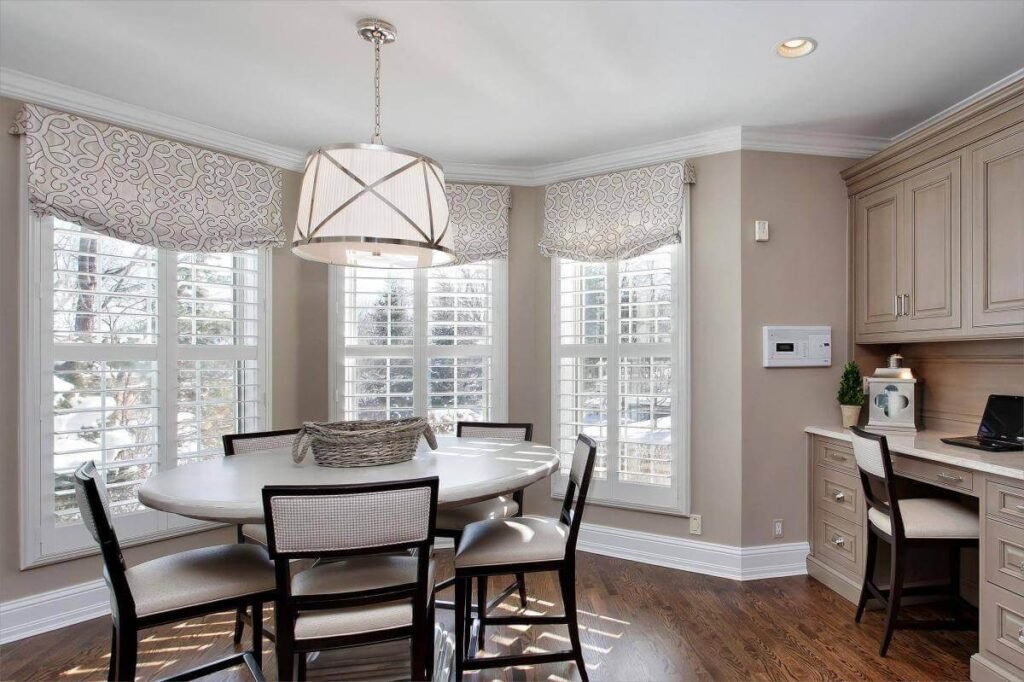
Remember, the key is experimenting and finding the combination that best suits your style and the overall ambiance you want to create in your space.
Inspiring Ideas and Creative Combinations
Create a timeless, sophisticated look by combining traditional plantation shutters with floor-length draperies. Choose shutters in a rich wood finish or crisp white for a classic touch. Pair them with elegant draperies in luxurious fabrics such as silk or velvet. Opt for curtain styles like pinch pleat or goblet crease to add a touch of luxury. This combination works well in formal living rooms, dining rooms, or master bedrooms.
Contemporary chic: Combining minimalistic shutters with sheer curtains.
For a sleek and modern aesthetic, pair minimalistic plantation shutters with sheer curtains. Opt for shutters with clean lines and a neutral color palette. Then, install sheer curtains of lightweight fabrics to maintain an airy and ethereal feel in the space. This combination allows ample natural light to filter through while providing a soft and elegant touch. It works well in contemporary living rooms, bedrooms, or home offices.
Coastal vibes: Nautical-themed shutters with breezy linen curtains.
Create a coastal-inspired look by combining nautical-themed plantation shutters with breezy linen curtains. First, choose shutters with a white or weathered wood finish to evoke a beachy atmosphere. Then, pair them with curtains made of lightweight linen in soft blue or sandy beige tones. This combination exudes a relaxed and laid-back vibe and works well in coastal-themed living rooms, bedrooms, or sunrooms.
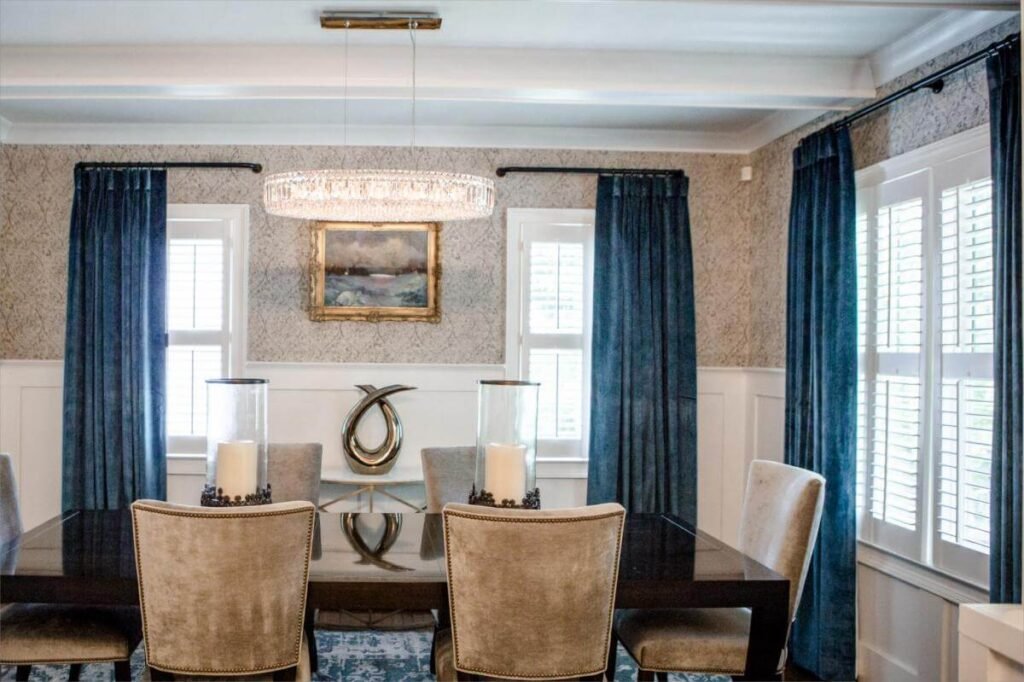
Creating drama: Statement shutters with bold and patterned curtains.
Make a bold statement by pairing statement plantation shutters with bold, patterned curtains. Choose shutters with decorative details, such as carved designs or unique finishes. Then, combine them with curtains featuring vibrant colors, geometric patterns, or large-scale prints. This combination adds drama and personality to any room, remarkably eclectic or bohemian-inspired spaces.
Window treatments for specific rooms: Living areas, bedrooms, and kitchens.
- Living areas: In living rooms or family rooms, consider combining plantation shutters with curtains that offer both style and functionality. Opt for sheer curtains for a light and airy feel during the day, and add heavier drapery panels for added privacy and light control in the evenings.
- Bedrooms: Bedrooms often require a balance of privacy, light control, and style. Pair plantation shutters with blackout curtains to create a cozy and peaceful sleep environment. The shutters provide privacy during the day, while the curtains block out light and add a touch of elegance and softness to the room.
- Kitchens: For kitchens where moisture and heat can be a concern, consider combining plantation shutters with cafe curtains. Install shutters on the lower portion of the windows to maintain privacy while allowing natural light to enter. Use cafe curtains on the upper part for a charming and functional window treatment.
Consider each room’s needs and functions when selecting the appropriate combination of plantation shutters and curtains. The goal is to create a cohesive and functional design that reflects your style and enhances the overall ambiance of the space.
Expert Tips for Installation and Maintenance
Remember to always refer to the specific guidelines provided by the manufacturers of your plantation shutters and curtains for the most accurate and detailed instructions on installation, cleaning, and maintenance.
Ensuring proper installation of plantation shutters and curtains:
- Measure accurately: Take precise measurements of your windows before ordering or installing plantation shutters. If you need more clarification, it’s recommended to consult a professional for accurate measurements to ensure a proper fit.
- Hire a professional: Installing plantation shutters can be a complex task. Consider hiring a professional installer with experience working with shutters to ensure proper and secure installation. They can also guide you on the best methods for installing curtain rods or tracks to complement the shutters.
- Follow manufacturer instructions: If you install the plantation shutters yourself, follow the instructions carefully. This will ensure the shutters are installed correctly and all components securely fastened.
- Consider weight and support: When installing curtain rods or tracks, make sure they are sturdy enough to support the weight of the curtains. Consider the type of wall (drywall, concrete, etc.) and use appropriate anchors or brackets for proper support.

Cleaning and maintenance guidelines for both elements:
- Plantation shutter maintenance: Regularly dust the shutters using a soft cloth or feather duster to remove any dust or debris. Use a mild solution of warm water and gentle soap for deeper cleaning. Avoid using harsh chemicals or abrasive cleaners that can damage the finish. Follow the manufacturer’s specific cleaning instructions for your type of shutter.
- Curtain care: Check the care label on your curtains for specific cleaning instructions. Most curtains can be gently vacuumed or shaken to remove dust. For washing, follow the recommended instructions for the fabric type. Some curtains may be machine washable, while others may require dry cleaning. Iron or steam the curtains to remove wrinkles if needed.
- Preventive maintenance: Regularly inspect the shutters and curtains for any signs of damage or wear. Repair or replace any broken or damaged components promptly to prevent further issues. Lubricate the shutters’ hinges or moving parts as the manufacturer recommends to ensure smooth operation.
Troubleshooting common issues and FAQs:
- Adjusting shutters: If your plantation shutters are not closing or aligning correctly, check for any obstructions or debris preventing smooth operation. Adjust the tension screws or hinges to ensure proper alignment and functionality.
- Curtain wrinkles: To remove wrinkles from curtains, lightly mist them with water and gently smooth the fabric. You can also hang the curtains and allow gravity to remove some wrinkles over time naturally. Avoid using excessive heat, as it may damage certain curtain fabrics.
- Dealing with light gaps: If you notice soft cracks around the edges of your shutters, check for any misalignment or warping. Adjust the hinges or contact a professional for repairs if needed. Adding blackout curtains or using heavier drapes can also minimize light gaps.
- Cleaning frequency: Cleaning plantation shutters and curtains depends on various factors, such as dust accumulation, location, and usage. Dusting plantation shutters every week or two and washing curtains every few months should suffice. However, adjust the cleaning schedule based on the specific needs of your space.
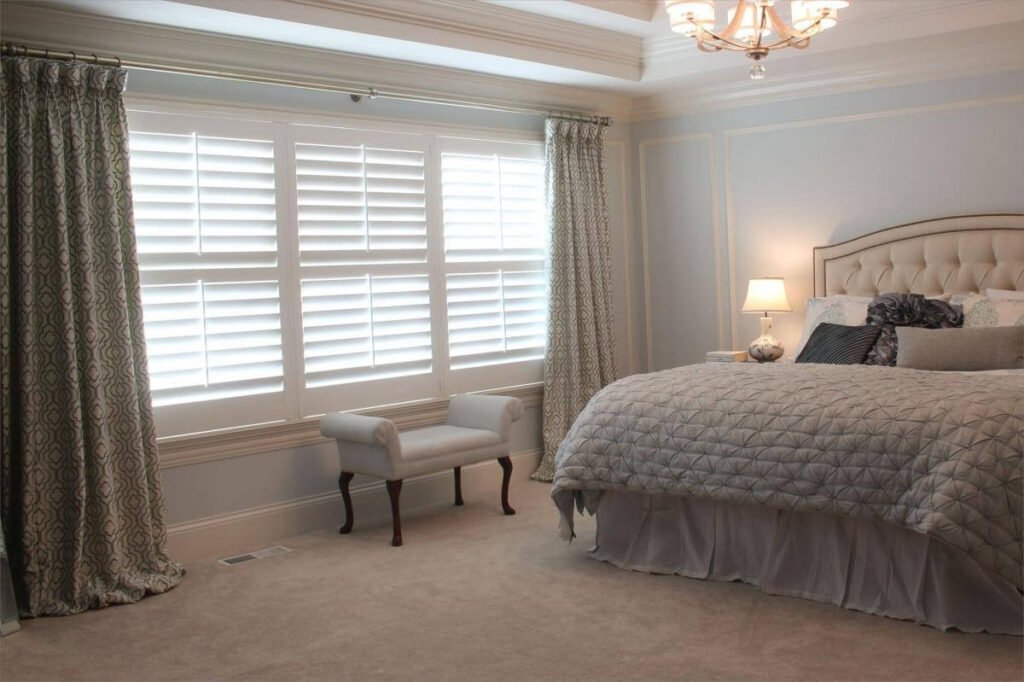
Unlock the potential of your windows by harmonizing the timeless beauty of plantation shutters with the elegance of curtains. From traditional to contemporary aesthetics, this winning combination offers endless possibilities for enhancing any space’s visual appeal and functionality. Discover your unique style and transform your home into a sanctuary of sophistication and comfort with plantation shutters with curtains.

Leave a Reply